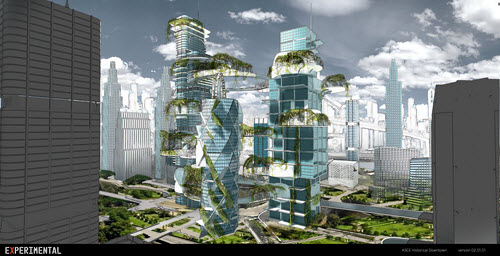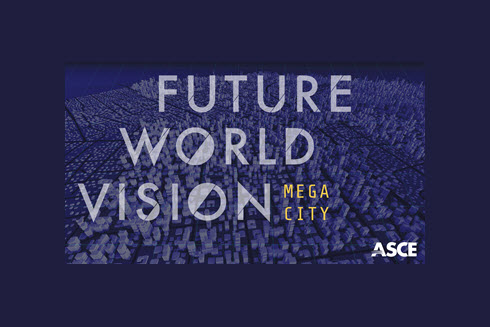The questions facing the megacity of the future are not simple.
Here’s a sample, for starters:
How does a city increase its density to accommodate 50 million inhabitants while preserving its historic character, promoting accessible green space and supporting a plurality of lifestyles and economies?
Not exactly the kind of question that can be answered in an afternoon. That’s why it’s so important that civil engineers start working toward tomorrow’s solutions today.
 And this is exactly what ASCE’s Future World Vision project does.
And this is exactly what ASCE’s Future World Vision project does.
ASCE’s Future World Vision is a deeply researched scenario-planning tool to help civil engineers consider the needs of the built environment 50 years from now. And an ASCE Future World Vision special virtual event, June 2, revealed what engineers can expect from the next phase of the project – the forthcoming megacity experience.
“One of my favorite aspects of the Future World Vision project is that it does not represent an ideal future,” said Elizabeth Ruedas, P.E., ENV SP, M.ASCE, leader of the Future World Vision social ethos group. “Instead, it is meant to serve as a provocation tool that raises red flags with regards to things that we might want to take a closer look at, or maybe completely avoid in the future.”
At the outset of the project, the Future World Vision research team identified six trends – alternative energy, autonomous vehicles, climate change, smart cities, advanced materials and policy/funding – to develop four future scenarios.
The first fully developed future world – the Floating City – debuted last fall at the ASCE 2019 Convention in Miami.
The second – the Megacity – is set for a full unveiling this October at the ASCE 2020 Convention.


As with the Floating City, the interactive, immersive Megacity is being constructed in a real-time 4-D computer simulation, allowing for both individual experiences and community collaboration.


Visitors to the Megacity can explore through several levels of interface – the city story, the energy lens, the transportation lens, the water and wastewater lens and the data view.


Experimental, the creative team behind the Floating City experience, is continuing its work with ASCE’s Future World Vision research cohort – including working groups on social ethos, communications and use cases – to develop the Megacity.
Learn more and find out how you can contribute to ASCE’s Future World Vision project.
Sign up for a monthly Future World Vision email to stay up to speed on the latest developments.



How much thought has been put into underground space ?
A significant, if not the most significant, factor why people have moved to cities in the past century+ is economic opportunity. Jobs brought people from rural areas & towns to cities, not just in the US but across the world. How many people worked in agriculture in 1890 or 1910 compared to now? How public health concerns, disease transmission such as the current COVID-19, may alter people to consider living in densely populated areas is an interesting dynamic that has generally not been an issue over this same time. It seems that public health in larger communities/bigger cities has been better than rural public health although that may be questioned now into the future.
Suburbia, or cities growing out instead of growing up, exists due to some people putting value on NOT being in the city/city center/heavy urban area, still having economic opportunity near the city or dealing with commuting back to the city for work.
The value of economic opportunity vs some risk of sickness/public health concerns might influence less dense living choices.
In regards to the listed six trends in this article, I wonder if pandemic response will end up being an additional consideration for such projects/scenarios.
The 19th Century vision of bigger is always better will not carry forth as we respond the feedback from our evolving SMART Community information. The key to resiliency will be based upon a net-zero mentality and interconnected fully independent islands of very wide mixed density population clusters based upon existing demographics, available resources and the technology based evolution. Communities dependent upon long logistical support chains will be at a disadvantage vs those with proximity to dwindling resources will grow to that level. The supply chain will be the control mechanism as we eclipse the mid point of the 21st Century. This is why the Net-Zero approach is essential and the only way there is to Rethink everything and how we do it. The challenge is that the present system is broken and is beyond repair and what we are looking at, and what we are caught in the jaws of is disruptive change and a Green Revolution based upon Visionaries. The future of our world depends upon this transition.
Future cities would mega as well as medium levels also. Should be Smart as well as carrying the mission of Economy with Ecology, to get sustainability to preserve its nature & living of mankind with nature.